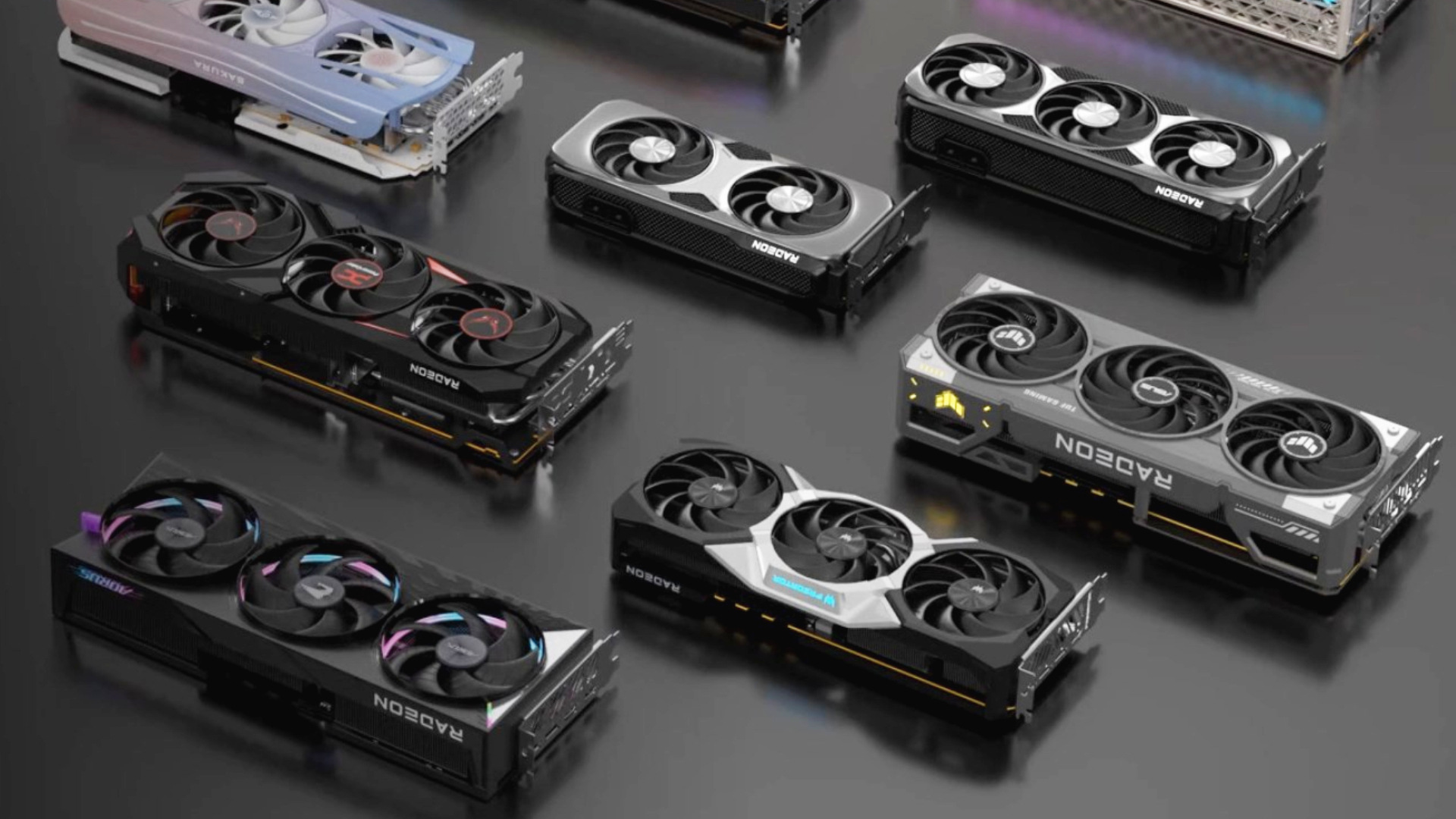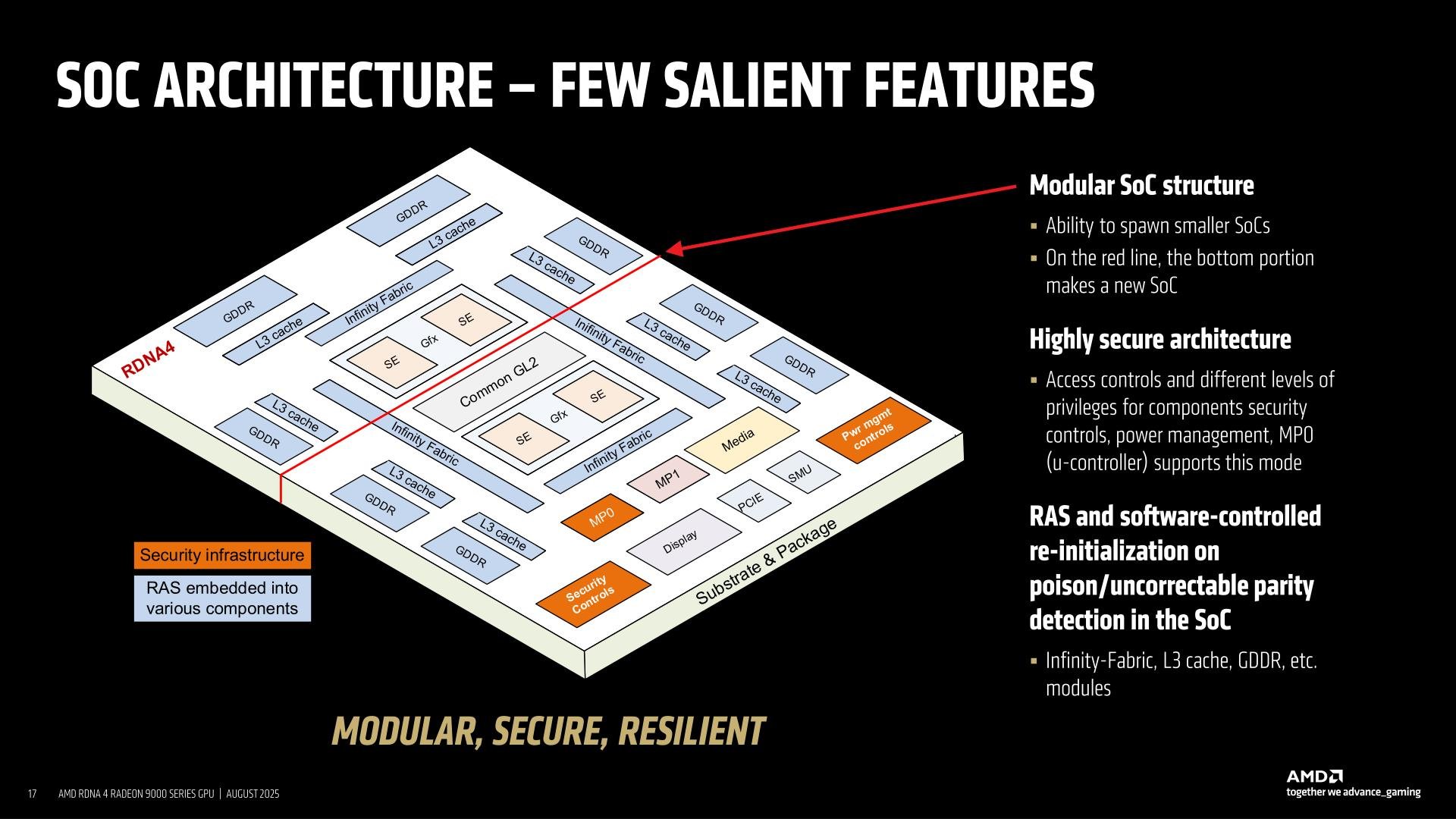AMD just revealed that its current RDNA 4 GPUs have a clever 'modular' architecture—here's hoping it signals a broader range of next-gen graphics cards
Let's have all the GPUs, please.

AMD's RDNA 4 GPUs, including the Radeon RX 9070 XT, have been out since February. But only now has AMD revealed that they are based on a clever modular architecture.
AMD held a deep dive into its RDNA 4 graphics tech at the Hot Chips 2025 conference yesterday. And perhaps the most intriguing new disclosure is RDNA's so-called "modular SoC architecture".
The idea is to allow multiple GPU configurations to be created more cheaply. so, what AMD says it has done with RDNA 4 is to design it in such a way that a base GPU SoC design can easily be scaled up to create a larger GPU.
Specifically, AMD's base SoC design contains two shader engines and four memory controllers, each with L3 cache. That base SoC also has the display engine, power management and other supporting elements.
To that base SoC can be added another two shader engines and quartet of memory controllers and cache, plus the required infinity fabric interconnect. The implication is that the entire design of the base SoC is repeated exactly on both the smaller base GPU SoC and the larger variant with the added shader engines. Thus the supporting elements in the base GPU, such as the display engine and power management are the same across all GPU variants.
This contrasts with typical GPU designs, where the layout and positioning of the various elements will vary from GPU to GPU. Each GPU design is basically bespoke. Should you peer inside, say, an RTX 5080, you won't see a carbon copy of the internals of an RTX 5070 with some bits added on. Each GPU has its own layout.
Anyway, for AMD this means it only has to design that base SoC layout once and in turn that creating the larger GPU variant is limited to adding the additional components, everything else is carried over using exactly the same layout. That speeds up design, validation, reduces the number of steps before the GPU is sent to the fab for manufacture and so on.
Keep up to date with the most important stories and the best deals, as picked by the PC Gamer team.
In terms of how this applies to AMD's current RDNA 4 GPUs, the Navi 44 GPU in the Radeon RX 9060 XT is essentially the base SoC with two shader engines and four memory controllers, while the Navi 48 GPU in the Radeon 9070 XT is the larger variant with the added shader engines, memory controllers, cache and so on.
The two GPUs still use different silicon. The smaller GPU isn't just the larger GPU with a bit physically sliced off. It's worth noting that would entail throwing away the additional shader engines, cache and memory controllers because they don't have the necessary elements, such as a display engine, required to actually be a functional GPU. But in terms of design and engineering, the modular approach makes the process faster and cheaper.
Given all that, it is slightly ironic that AMD has only produced a relatively narrow range of GPUs for this current RDNA 4 generation. But it's not clear the modular approach of RDNA 4 was ever intended to extend beyond the quad shader engine design of the Navi 48 GPU.
Put it this way, if you look at the size and shape of Navi 48, it's already a distinctly rectangular chip. Adding another two or even four shader engines and associated hardware would result in the very long and thin chip. Whether it's internal or external interconnects, not to mention chip packing, there are probably limits to how far this modular approach can be taken.

As for what this implies about AMD's future GPU designs, it's hard to say. This is all subtly different from the chiplet engineering that AMD has used to such success in its Ryzen CPUs. AMD did actually have a crack at chiplets for RDNA 3 and graphics cards like the Radeon RX 7900 XTX, of course, only to return to monolithic GPUs for RDNA 4.
There are rumours that AMD is planning on a return once again to chiplets for its next-gen graphics, variously referred to as RDNA 5 and UDNA. According to some rumours, AMD has cooked up a new mid-range GPU roughly equivalent to the Navi 48 chip in the RX 9070 XT, codenamed AT2, with 64 compute units.
But the interesting bit is that as many as three AT2 GPUs can allegedly be combined to make AT0, a new high-end monster with up to 192 compute units, though it's claimed the gaming version of this beast will be limited to 154 CUs.
For context, and always bearing in mind that compute units can't be directly compared across generations, Navi 48 has 64 compute units. Of course—and this is where the "modular" disclosure this week may come in—it's possible that RDNA 5 isn't chiplet-based, per se, but that AMD's AT2 GPU is a new base SoC that can be scaled up in design terms to create larger monolithic CPUs, just as Navi 44 is scaled up to Navi 48.
Anyway, this is all speculation for now. But here's hoping AMD revealed the whole "modular SoC architecture" thing yesterday in order to hint at plans for a broader range of GPUs from its next-gen architecture, including a top-end beast to keep whatever Nvidia has planned to replace the RTX 5090 honest.

1. Best overall: AMD Radeon RX 9070
2. Best value: AMD Radeon RX 9060 XT 16 GB
3. Best budget: Intel Arc B570
4. Best mid-range: Nvidia GeForce RTX 5070 Ti
5. Best high-end: Nvidia GeForce RTX 5090

Jeremy has been writing about technology and PCs since the 90nm Netburst era (Google it!) and enjoys nothing more than a serious dissertation on the finer points of monitor input lag and overshoot followed by a forensic examination of advanced lithography. Or maybe he just likes machines that go “ping!” He also has a thing for tennis and cars.
You must confirm your public display name before commenting
Please logout and then login again, you will then be prompted to enter your display name.


